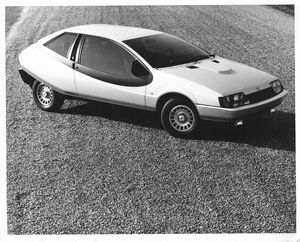|
By accessing or using The Crittenden Automotive Library™/CarsAndRacingStuff.com, you signify your agreement with the Terms of Use on our Legal Information page. Our Privacy Policy is also available there. |

MEGASTAR II
|
|---|
|
|
MEGASTAR II
Public Relations, Ford Division
1979
IMMEDIATE RELEASE
The Megastar II, a Ford Motor Company design concept car for the family of the future, will be shown by Ford Division at major auto shows in the United States this year.
First shown at the Geneva, Switzerland, International Motor Show, the Megastar II was developed by Ford's Ghia Operations in Turin, Italy. Based on Ford's European Taunus Sport, the futuristic, silver-and-black wedge-shaped sedan offers seating for five people.
"Although not a production car, the Megastar II demonstrates ideas and concepts that might be used on Ford cars of the future," said Filippo Sapino, Ghia's managing director.
"On our Megastar project, we have paid particular attention to aerodynamics," he added. "The sleek design helps conserve energy and improve fuel economy and performance."
Megastar II is built on a 101-inch wheelbase and is equipped with a two-liter, four-cylinder engine and four-speed manual transmission, independent front- and rear-suspension systems and aluminum road wheels.
The front of the car incorporates a louvered, airfoil grille with four headlights recessed behind clear plastic covers. Additional halogen driving lamps are located beneath an impact-absorbent front bumper, also shaped for reduced wind drag.
Megastar II's tailgate opens to the top of the rear bumper, with the assistance of gas-filled struts. The rear seats fold down individually to provide additional luggage space.
Teardrop-shaped door windows are lowered electrically, and front-hinged quarter windows can be opened for the comfort of rear-seat passengers.
The interior of Megastar II features black leather upholstery and black carpeting with orange stripes to reflect the car's exterior color scheme.
The instrument panel is a modular unit behind the padded four-spoke steering wheel. Instruments and controls always are illuminated behind a heavily tinted screen for reflection-free visibility.
Dual exterior mirrors can be adjusted electrically from the driver's seat.


















